

ALAN CHARLTON, a researcher with Seaham Family History Group, has carried out an extensive research into local newspapers from 1858 onwards.
As a result of his work, editions of THE NORTH EASTERN NEWS , THE SEAHAM OBSERVER and THE SEAHAM WEEKLY NEWS are available to group members.
The editions can be accessed via a number of CD's and memory sticks which are held by the group at Seaham Library and can be viewed during one of the group meetings.
The front page of each newspaper edition
(where available) has been uploaded and can be
maximised to enable each article to be easily
read.
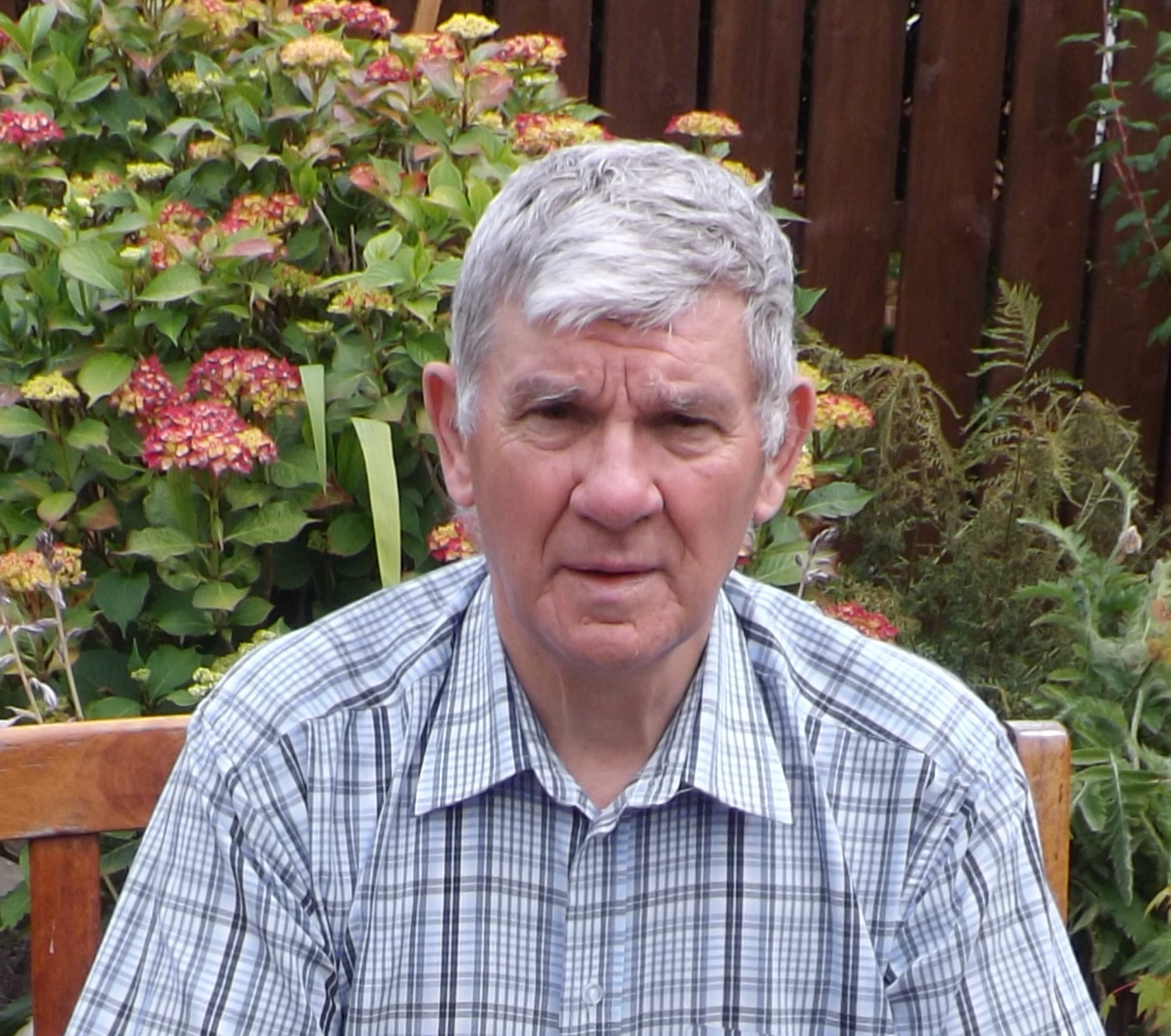

The body of Britains Unknown Warrior was carried from Ypres to Boulogne and then to Westminster.
Click below to read Alans's complete and fascinating account of this journey including a wealth of images and pictures taken from contemporary souces.
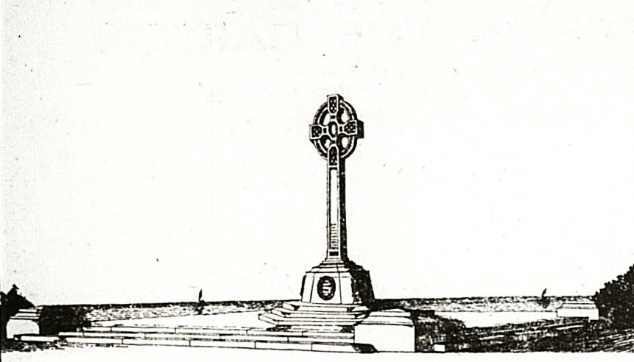
In the presence of a vast concourse of spectators, the Seaham Harbour War Memorial was unveiled on Sunday afternoon [20/08/1922] by the Marquess of Londonderry, and dedicated by the Rev Canon Colling [Vicar].
Lord Londonderry was accompanied by Lady Londonderry and Viscount Castlereagh.
The other robed clergy taking part in the proceedings were Rev Graham White, C.F. [vicar of Dawdon], and the Rev S. C. Kearney [vicar of Seaham].
The local police, in charge of Inspector Morgan, lined the approach to the memorial. Many of the men wore medals and war honours. Many decorations were also noticeable among the members of the 55th Northumbrian Brigade, who were present under the command of Major Milburn. The other officers of the same Brigade in attendance were Col. Waring [adjutant]. Major Warham, Major Wilson, Capt. Tomkins and Lieut. Sparks. Other officers present were Major G. W. Hardy, Capt. C. W. Spanton, Lieut, H. Webb and Lieut. C. V. Neill. Members of the local coastguard were under the command of Station Officer Husk, R.N.
The Seaham Harbour Girl Guides, in charge of Miss Dillon, formed a guard of honour at the entrance to the green.
Among those also present were Mr and Mrs Malcolm Dillon, Coun. J. W. Claxton [chairman of the War Memorial Committee], Mr H. P. Harding [hon. treas.] and Mr Jas. W. Richardson [hon. sec.], Councillors D. Sharvin, J. Elgey, J. W. Scott, F. W. Armstrong, T. Curry, W. C. Hudspith, F. Young, R. Forster, J. S. Ankers and W. B. Cockburn; Messrs J. C. Edington, L. G. Dillon, T. A. Lawton, T. K. Ward, S. Smith and G. Guy.
The ceremony was attended by representatives of the Royal Navy, 55th Northumberland Brigade R.G.A. [T.F.], members of the local branch of the British Legion, other ex‐servicemen, the choirs of the various churches, Sunday school children, friendly societies and lodge representatives.
The bands of the 55th Northumbrian Brigade and Salvation Army accompanied the hymns.
The dedication service was very solemn and appropriate. The open hymn was “For all the saints,” after which the Rev H. Neill read from Rev. xxxi, 1‐5 “And I saw a new heaven and a new earth.” Then followed prayers by Mr Neill after which Lord Londonderry drew aside the Union Jack covering the memorial. The prayers of dedication were next recited by Canon Colling, and the Seaham Sea Scouts sounded “Last Post” and “Reveille” in a very impressive manner. A short silence was observed, and the service concluded with the hymns “Eternal Father,” and “O God our Help,” followed by the doxology and the national anthem.
Lord Londonderry placed a wreath on the memorial, as did also Coun. Claxton, chairman of the Memorial Committee. Wreaths were also deposited by public bodies, townspeople and relatives of the fallen.
Lord Londonderry said it was his melancholy and triumphant duty to unveil that beautiful memorial to those of their fellow townsmen who fell in the great war. He almost felt that after the eloquent prayers which they had heard and the beautiful strains of the music, that any expressions from him would be superfluous. But somehow, in those familiar and beloved surroundings he took a pleasure in performing that sad duty.
They were gathered there, proceeding his lordship, with deep feelings of reverence, affection, and triumph, in the thought of the splendid sacrifices which so many of their friends made.
The numbers were an eloquent tribute to the spirit of Seaham Harbour. Of their friends, 400 fell, and they continued in their memories not only by their deeds and by their characters, but also by that beautiful monument.
He remembered well, in the early days of the war, how his heart swelled with pride when he heard of the response which Seaham Harbour made, spontaneously and voluntarily to the call to arms. The men of Seaham flocked to the standard and they did their duty. They maintained the splendid traditions not only of Seaham Harbour, but of the country of which they were so justly proud.
“Some returned and you welcomed them home. The others remained in a foreign land.”
Here Lord Londonderry was overcome by emotion, and after a pause proceeded. “You must excuse me, ladies and gentleman,” he continued, “if my feelings overcome me on this occasion. The ancients had a theory that those who died on the field of battle passed immediately to that rest and happiness, which we all hope to reach and which we all long for and I cannot but feel that those splendid men passed straight across the unknown barrier and were greeted by those which we read in the Bible, “Well done thou good and faithful servant, enter thou into the joy of thy Lord,” and I do feel that we should realise the great deeds which these men have done and the great example which they have laid down for us to follow, and that after the clash of arms which has bereaved so many of our families and left gaps which will never be filled, we should realise that it is our duty and our heritage to carry on what they would have done had they lived.”
He knew that in the four years which had passed since these heroes watered many a foreign battlefield with their blood, our hearts had faltered and we had wondered why this struggle came and why we had passed through all this sorrow. “These are matters,” concluded his lordship, “which the Almighty knows best, but I know that our duty lies not only in looking back on the memories of those splendid men, but also in looking forward and feeling that our duty lies in whatever direction it can possibly be to leave the world in a better state than we found it. I take as I have said a melancholy and a triumphant pleasure in unveiling this beautiful memorial. May it be comfort and solace to the old and at the same time stimulating and encouraging example to the young.”
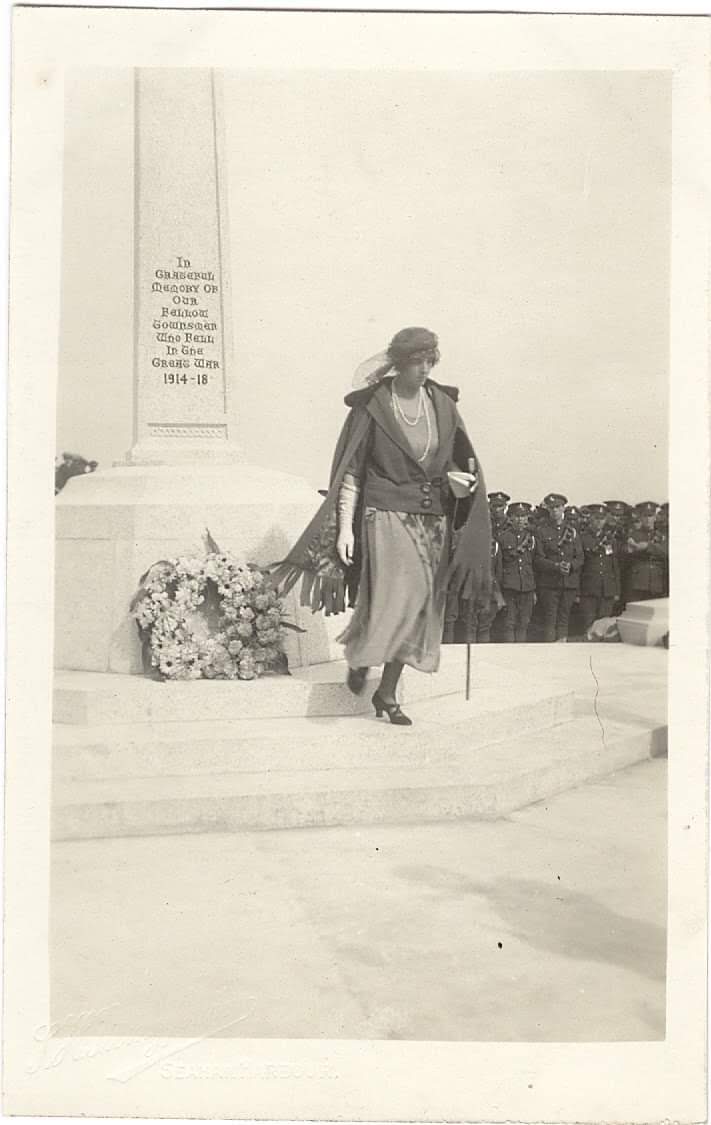
Lady Londonderry at the unveiling ceremony
Source:
Local Studies
Sunderland
Seaham Weekly News
No. 3,244. – Friday, August, 25th 1922

War Memorial today
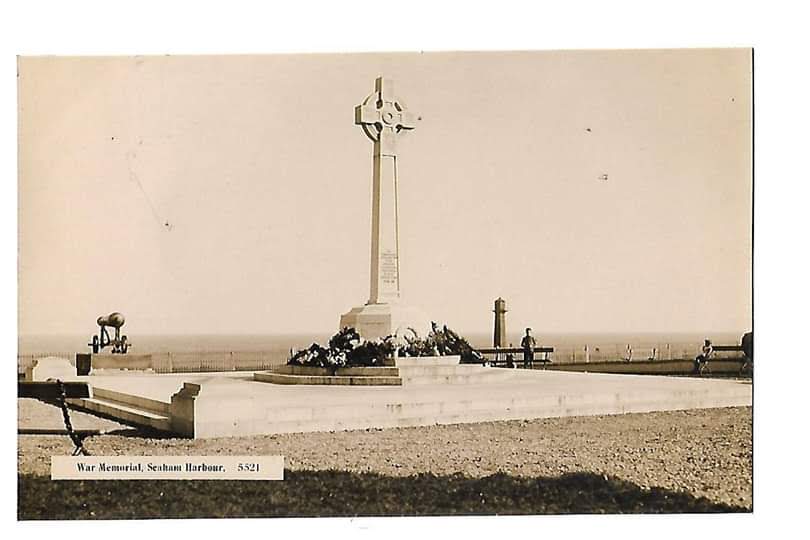
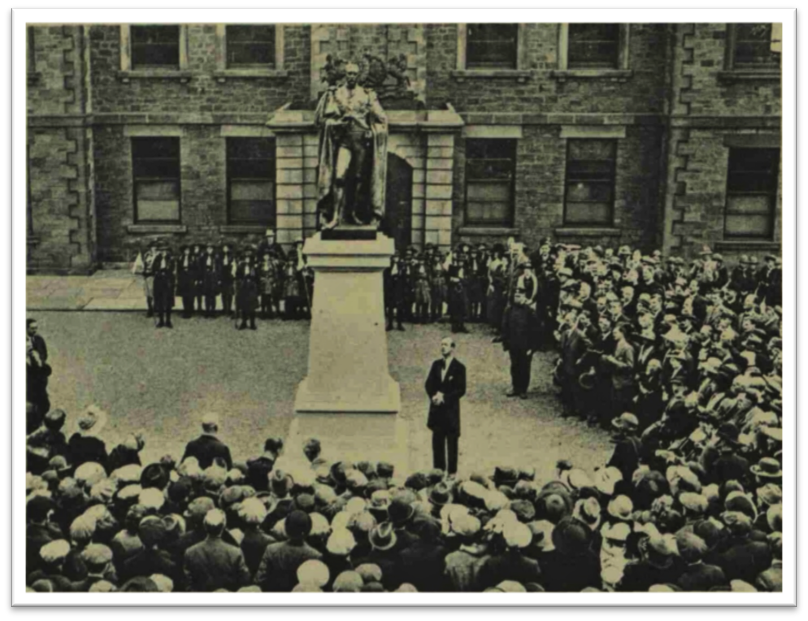
A statue of the late Lord Londonderry is to be unveiled by Lord Londonderry tomorrow afternoon [Saturday, August, 26th 1922] at 3:30pm
The statue, which stands at the entrance to the Londonderry Offices, opposite North Terrace, has been erected by Lord Londonderry and his sister, Lady Ilchester.
The late Lord Londonderry is depicted in his garter robes, and in one hand holds the drawing of the sinking of Dawdon Colliery, one of the most important industrial enterprises of his life. The figure is of bronze, 10 feet high, standing on a pedestal of Heworth stone 10 feet high, the whole reached a height of 10 feet. The statue itself weighs 15 cwt.
The inscription on the pedestal reads:-
“Charles Stewart Vane-Tempest Stewart,
Sixth Marquess of Londonderry, K.G., G.C.V.O.
Viceroy of Ireland 1886-1889,
Chairman of London School Board 1895-1897.
Postmaster General 1900-1902.
President of the Board of Education 1902-1905.
Lord President of the Council 1903-1905.
Born 1852. – Died 1915
This statue is placed here by his son and his daughter, amongst those whom he loved so well, and whose welfare and happiness were to him the principal objects of his life.”
The pedestal is adorned with the Londonderry coat of arms and the family motto “Metuenda Corolla Draconis” [The dragon’s crest is to be feared].
The statue is the work of Mr. John Tweed, the well-known sculptor, who was selected to complete the Alfred Stevens monument to the Duke of Wellington, in St. Paul’s Cathedral. Mr. Tweed’s more recent efforts include the statue of Admiral Lord Beresford in St. Paul’s, and the King’s Royal Rifle Corps memorial at Winchester. He is now engaged on the national monuments to Mr. Joseph Chamberlain and Lord Kitchener, and the portrait bust of Lord Roberts for St. Paul’s. His work is also known in the north of England, as he designed the monuments to Col. Benson at Hexham and Mr. Joseph Cowan at Newcastle.
The pedestal has been executed by Messrs John McMillan and Sons, Sunderland.
The connection of the Londonderry family with Seaham now dates back 100 years, for it was in 1822 that the third Marquess purchased the estate from the Milbankes. Lord Londonderry resolved to construct a harbour among the rocks of Seaham, which should furnish the means of export to the vast coal fields in the vicinity. On [Saturday] November, 28th1828, the foundation stone of the harbour was laid by Lord Londonderry and the same day Lord Seaham laid the foundation stone of the first house of Seaham Harbour. In July, 1831 the first cargo of coals was shipped. By 1861 Seaham Harbour had 8,000 inhabitants and was shipping 700,000 tons of coal per annum.
Throughout the remainder of his life Lord Londonderry lost no chance of developing the town and its resources and one of his last projects was the construction of a passenger line to Sunderland, which was almost unique in being the property of one man.
The late Lord Londonderry, who was the sixth Marquess, succeeded to the title in 1884. Born in 1852, he was educated at Eton and at Christ Church, Oxford. He married in 1875, Lady Theresa Susey Helen Chetwynd Talbot. Eldest daughter of the 19th Earl of Shrewsbury.
Like his ancestors, the Marquess was a keen politician and a staunch supporter of the Unionist cause. In 1878 he was returned for County Down, a constituency which he continued to represent until his accession to the peerage.
In 1886 he was appointed Viceroy of Ireland and held this office until 1889. In maintaining the viceregal dignity, he was ably supported by the Marchioness.
Lord Londonderry was chairman of the London School Board from 1895 to 1897, and in various ways helped forward the cause of education. In the Unionist administration between 1900 and 1905 he occupied important posts. He was Postmaster General from 1900 to 1902 and President of the Board of Education from 1902 to 1905. He also held the office of Lord President of the Council from 1903 to 1905.
He became a Privy Councillor in 1886 and a member of the Irish Privy Councillor in 1892. He was chosen as an aide-de-camp to Queen Victoria in 1897. Other honours he held were Knight of the Garter and Knight Grand Cross of the Royal Victorian Order, while he was also a Justice of the Peace and deputy Lieutenant for the County of Durham.
Lord and Lady Londonderry excelled in the roles of host and hostess and frequently entertained Royalty at Wynyard and their other country seats.
In the affairs of Seaham Harbour, the late Lord Londonderry took a very active part. He was honorary colonel of the 3rdNorthumbrain [County of Durham] Royal Field Artillery [T.F.] which succeeded the 2nd Durham [Seaham] Volunteer Artillery raised by the Londonderry family in the early days of the volunteer movement. Previously he was Colonel of the 2nd Durham’s. He was intimately connected with all institutions of the town and a liberal supporter of all its organisations for the public good.
During the last 20 years of his life a wonderful change was brought about in his industrial concerns. In 1897 he resolved to extend the harbour. In 1899 the old docks were taken over by a public company, of which his Lordship was the largest shareholder and the new dock and piers were constructed.
In 1900 the Londonderry Railway was sold to the North Eastern Railway Company and now forms part of the coast rout between Sunderland and West Hartlepool.
Perhaps his lordships greatest enterprise, however, was the sinking of Dawdon Colliery, which was started in 1898 and which is now a flourishing concern, supporting a new community of about 8,000 inhabitants.
Seaham Weekly News
No. 3,245. – Friday, September, 01st 1922
The statue to the late Marquess of Londonderry, erected at the entrance to the Londonderry Offices, was unveiled on Saturday afternoon, August, 26th by Lord Londonderry, before a large attendance of townspeople.
Lord Londonderry was accompanied by Lady Londonderry, Viscount Castlereagh, Lady Maureen Stanley, Lady Allendale, the Countess of Ilchester, Lady Mary Fox Strangways, Viscount Stavordale, and the Hon. John Fox Strangways. Among those also present were Mr Malcolm Dillon, M.B.E., and Mrs Dillon, Miss Dillon, Capt. N. M. Dillon, Mr L. G. Dillon, Capt. N. W. Apperley, M. V. O., Mr John Tweed, Revs. Canon Colling, H.T. Churchyard, T. Copley, Graham White, S. C. Kearney, and W. R. Wyldbore Smith, Mr and Mrs W. A. Swallow, Mr F. Wilson, Mr R. Wilson, Coun. and Mrs J. W. Claxton, and Mrs W. B. Cockburn, Coun. D. Sharvin, Coun. J. Elgey, Coun. T. Curry, Mr. J. C. Edington, Mr and Mrs J. W. Hall, Mr R. and the Misses Warham, Mrs Scott, Mrs John Warham, Mr and Mrs T. K. Ward, Mr and Mrs G. H. W. Gardiner, Mr G. W. Hardy, Mr and Mrs W. S. Anderson, Mr John Harrison, Mr Mark, Mr and Mrs T. Turner, Mr and Mrs R. Grimes, Mr J. F. Black, Inspector Morgan, D. C. C., Coun. and Mrs F. Young, Coun. W. C. Hudspith and Capt. and Mrs J. Adamson.
The 55th Northumbrain [Medium] Brigade R. G. A. [T. F.], was represented by a number of officers, N. C. O’s and men from all batteries. The Brigade, of which the present Lord Londonderry is honorary colonel, is the successor to the pre-war 3rd Northumbrain Brigade, of which the late Marquess was honorary Colonel. Col. J. Lynn Marr, O. B. E., was in command and the other officers on parade were Col. J. Waring [adjutant], Major H. Wilson, Major W. Milburn, Major E. H. Caspar, Major J. Warham, Capt. N. Dugdale, Lieut. L. H. McRobert, Lieut. Nicholson and Lieut. Sparke.
The band of the Brigade, under the leadership of Mr E. Coltham, attended and played pleasing selections
Among those also taking part were the Seaham Harbour Girl Guides, under the command of Miss Dillon, and the 1stSeaham Harbour [Londonderrys’ Own] Boy Scouts.
Lord Londonderry said he had taken upon himself the task which he knew could be far more adequately performed by a great many others, but in the invitations which he had issued he had been unfortunate, owing to many circumstances and he was sorry to say that it had been quite impossible for him to get one of his father’s old friends to come and perform the ceremony. He sometimes felt that that on an occasion such as that there was hardly any need to give expression to their thoughts when he looked at the people assembled in front of him that day and saw so many of his old friends, he knew that they were all deeply appreciative of one whose heart was so filled with the desire for the well-being of those among whom he was born and bred. It occurred to his sister and himself that they would like to place a memento of their father in that town, in the place, as they had recorded on the statue, he loved so well, as a lasting monument to his life’s work. “I hardly feel that there is any necessity,” proceeded his lordship, “if I may use the expression, to take any active steps to keep my father’s memory green. I see it on all sides, not only here but in the North of Ireland that he has left a place in the hearts of so many which no one will ever fill.” His life was spent in thought for others. He occupied many proud positions in the service of the state, but his real moments of happiness were when he was at his own and amongst those who always showed him such loyalty and affection. He therefore felt that the best tribute which his family could pay to his memory was to erect in the town a monument of him, so that the present generation and generations to come would be able to look on the features of one who had been so much associated with the town and the prosperity with the town and the prosperity which surrounded it. His name would ever be associated with the great colliery of Dawdon. It was due to his enterprise and foresight that one of the most striking examples of modern mining had come into being in the colliery which was now giving work to so many men.
He should not think, continued Lord Londonderry, of going through the life history of one whom they all knew so well. He was fortunate in a great many ways, but one must always remember that to whom much was given, of him much was required. No one realised more than his father that property had its responsibilities as well as its privileges, and he thought they would agree that no one attempted more fervently or more earnestly and perhaps also no one attempted more successfully to discharge the onerous duties which fell upon him. “I can assure you, that the lesson which he always sought to inculcate in myself was the duties which I should have to discharge when he was no longer there, and I can only say that if I have fallen short or if I do fall short, it is my own fault.
Lord Londonderry concluded by congratulating Mr John Tweed on the excellence of his work with regard to the statue. They were fortunate, he said in obtaining the services of the foremost sculptor of the day and the monument did him every credit.
Coun. D. Sharvin said that as chairman of the Seaham Harbour Urban District Council and thereby representing the inhabitants of the town, he was glad to have the opportunity of saying a few words on the occasion of the unveiling of a monument to the late Lord Londonderry. They had read in the newspapers within the last few days, the splendid record and the great public services of the late Marquess and he thought in no place was that record read with such pride as in Seaham Harbour. There was no public institution in the town with which he did not identify himself and no charitable object to which he did not subscribe. They all knew him as a great, charitable, genial and hospitable landlord. He was a noble statesman, an honest man, and a true friend. Personally, said Mr Sharvin, it was a great pleasure to him that the town of Seaham Harbour had been chosen by his son, the present Lord Londonderry, and by his daughter, Lady Ilchester, as the place to erect the beautiful statue which had been unveiled, and he could assure Lord Londonderry and the members of his family that the people of Seaham Harbour highly appreciated it. [Applause]


On Friday August 4th, 1914 Britain declared war on Germany.
The Seaham Weekly News printed the official notification in its next edition on Friday 7th.
Although very familiar to us today, the poster shown here was not the one used but you can click on the links below to read the stirring words of Lord Kitchener's appeal to the 'Men of Durham" and Seaham events in the first few days of the war.
The Marquis of Londonderry immediately placed Seaham Hall at the disposal of the authorities as did Mr and Mrs Pemberton with Daldon Tower. Both were to be used as hospitals if so needed. Within days 50 beds were ready for patients, the public helping with beds and bedding and the Dawdon branch of the Ryhope Co-operative Society undertaking to supply horses and trolleys for transport purposes.
As soon as it became known that a state of war existed between England and Germany Customs officials impounded a German steamer in Seaham dock.
The Comet was an ordinary collier which had been lying in South dock for several days. The officers and seamen on board were handed over by the police, as prisoners of war, to a military escort. A large crowd watched their progress as they were marched from the dock to the railway station where they were to catch the 5.20 train for Sunderland.
It was commented that
there was no demonstation from the crowd.
At the same time the steamer Seaham Harbour of the Londonderry fleet was impounded at Hamburg. It was under the command of Capt. T. H. Shilling of Maureen Terrace and had a crew of 22, most of whom were Seaham men.

The crew of The Comet and military escort in Church Street.
In the afternoon of July 1st 1923 the war memorial to commemorate the 165 men who lost their lives in WW1 was unveiled by the Marquess of Londonderry in New Seaham Recreation grounds.
This impressive memorial stands 30ft from the ground and features lifesize figures, 5ft 9ins high, of a sailor in the Royal Navy representing the senior service and a soldier of the Durham Light Infantry representing the Army, standing with arms reversed. The airmen are commemorated by the badge of the Royal Air Force.
The monument is surmounted by the figure of Liberty holding a torch. This statue is 8ft 6in high.
The memorial was designed, modelled, carved and executed by Messrs Ainslie and Collin, a firm composed entirely of disabled ex-servicemen. The cost was in the region of £1,300, money being raised by workmens contributions and public subscription.
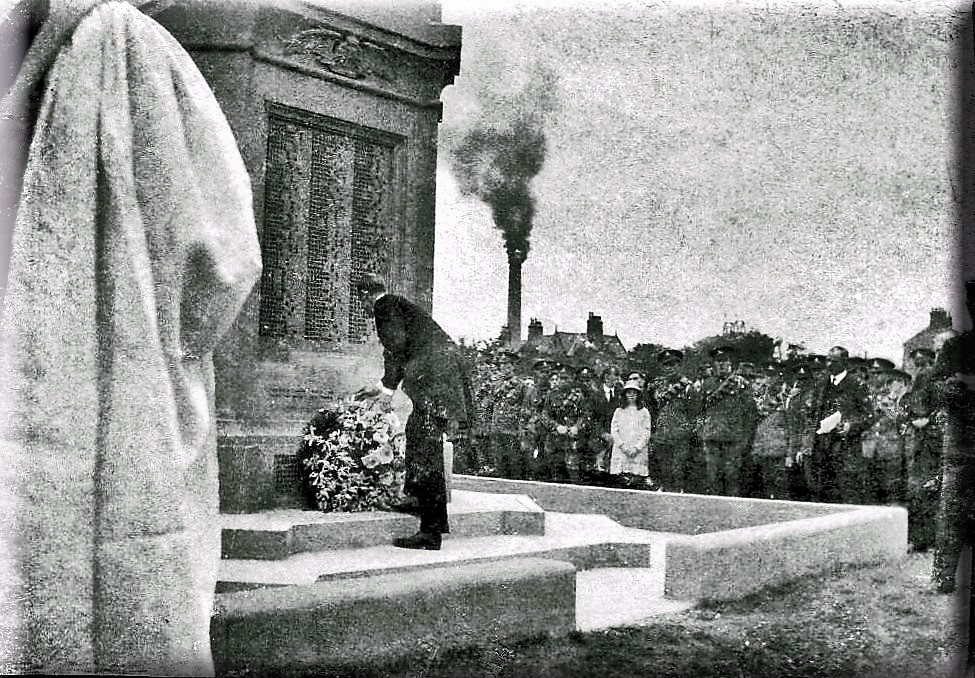
Lord Londonderry placing a wreath at the base of the war memorial
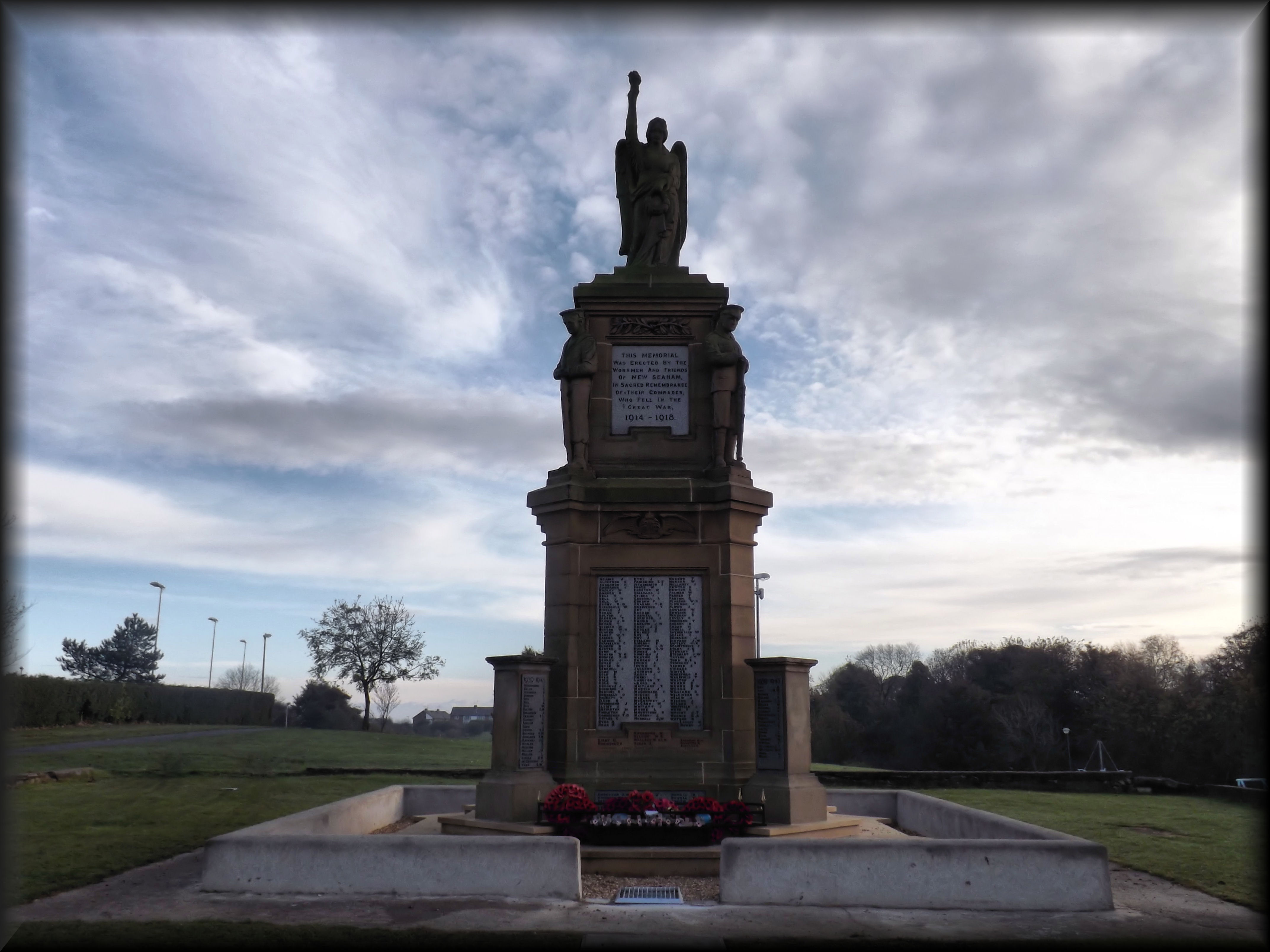
above
The badge of the Royal Air Force to
commemorate the lost airmen.
right
The figure of Liberty holding a torch
________________________
January 16th 1858
The paper was published by David Atkinson and the price 1d



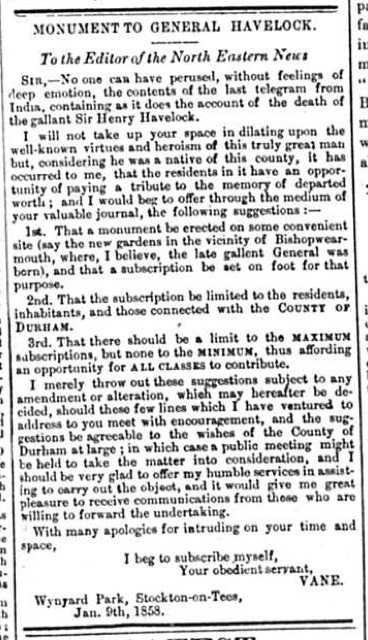
Just
two editions of the
NORTH EASTERN NEWS
from1858 have been
selected here to give an example of what can be found in the
collection. The articles in each edition range from
local news to world news, from business promoting adverts to
humerous stories.
By noting the way language itself was used, as well as the events being described, we can gain an insight into the world inhabited by our ancestors.
As well as looking for a particular event why not use this archive to give you a flavour of what was happening at the time of a birth, a marriage or a death in your family history.

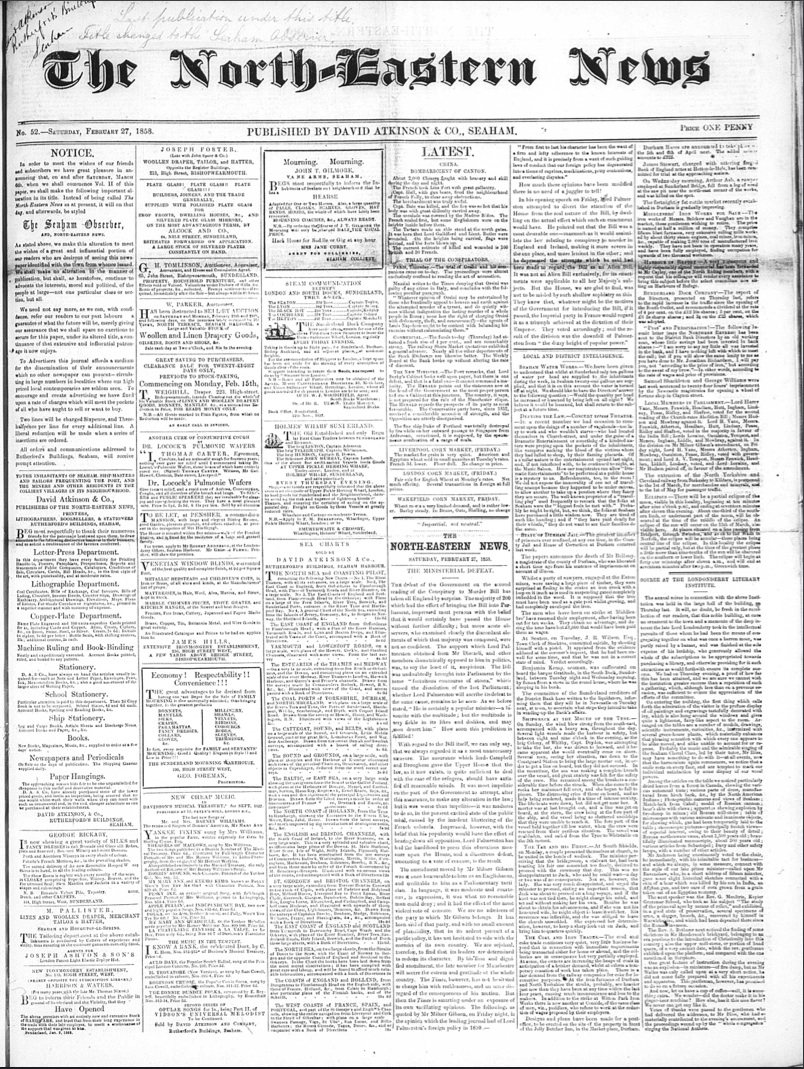
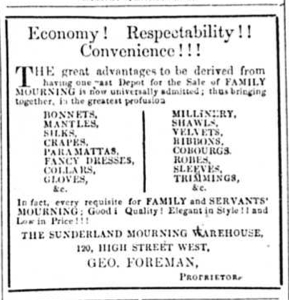
The Victorian era from 1837 to 1901 was a time when customs and practices relating to death were enormously important.
In fact Victorian funerals were big business and catered for all sections of society.
As these adverts show, the mourning process was rigidly governed by convention. Clocks in the house were stopped at the time of death and curtains were drawn. The code for dress, especially for women was quite detailed as what was and was not appropriate activity.
Men, because they still had to carry on the business of the day, were less bound by convention.
Death in the lower and labouring classes was understandably less bound up with the rituals.
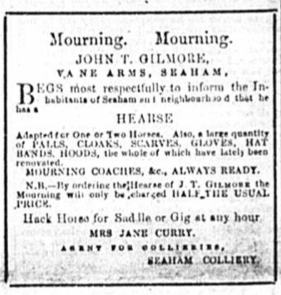
_________________________________________

Who were the Misses Carter? The Seaham Observer describes them such –
‘The amiable ladies are residents of Harrogate, in Yorkshire, well known as a fashionable watering place. They are greatly respected and esteemed for their good qualities, being extremely charitable and full of sympathy for their fellow creatures. Connected with them are also four brothers, damask manufacturers, at Barnsley Yorkshire. They are, we understand, the largest manufacturers of this material in the world. They are also noted for their charible character, and reside at Harrogate, where they enjoy the esteem of their townspeople. The cost of the boat has been raised by the Misses Carter over a period of thirteen months by the sale of fancy work.”
The Seaham Observer recorded the progress of this event from the initial offer of a lifeboat in March 1870 to its arrival on a carriage in a grand procession in September of that year.
Click on each of the files to read the original article
This file is of particular interest as it describes in detail the lifeboat, the boathouse and in particular the appearance of the town as people lined the streets with anticipation and pride to welcome the procession bringing the new lifeboat the “Sisters Carter”
Watson Town was the name of a tenemented street of thirteen houses built in 1870 for employees of ‘Watson, Kipling and Co.’s Chemical Works'
The Chemical Works were built in 1863 and soon began trading in soda crystals and magnesia. The company was successful and sent one shipload per week to markets in London and Ostend. At its peak 300 men were employed many of whom lived in Watson Town. This street was situated between the Chemical Works and Blast furnaces

It was the intention of the company that Iron could profitably be made at Seaham. The hope Watson Town was that in time they would branch out into making rails, iron bars and ship’s plates.
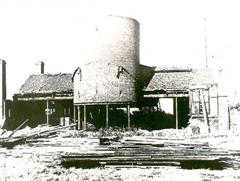
Seaham Chemical Works prior to demolition
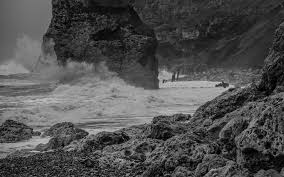
Chemical Beach got its name from the nearby Seaham Chemical Works
Sadly by 1885 due to national overproduction and
falling prices the firm was declared bankrupt.
The Chemical Work buildings and blast furnaces were left to deteriorate and were demolished in 1900 to make way for the sinking of Dawdon pit.
Watson Town however survived a little longer as it was occupied by the German pit sinkers.
FOOTNOTE:
John Watson who retired in 1881, lived in Vane House and was a keen astronomer, being a Fellow of the Astronomical Society.
He died in 1885, the same year the firm was declared bankrupt and was the first person to be buried in Seaham's new Princess Road Cemetery
Click on the link below to read the original news aricle as it appeared in the SEAHAM OBSERVER on June 4th 1870

At 10.20 pm on Tuesday 11th July Seaham inhabitants were startled by loud reports and flashes could be seen at sea. Those near the coast saw a German submarine about a quarter of a mile from the harbour entrance.
About 39 shells were fired from a 3 inch gun. Flying high overhead, none fell in the town itself. Twenty rounds fell in the direction of Dalton-le-Dale and a dozen rounds fell in and around Seaham Colliery.
Although many of the shells landed harmlessly in nearby fields one was to prove fatal.
One woman, Mrs. Mary Slaughter,35, of Hebburn, was staying with her cousin and the two women made their way home through the colliery yard as the shells began to drop. The cousin, Jennie Brown, was uninjured but Mary was hit by an exploding shell and was severely injured. She was treated and then taken to Sunderland Royal Infirmary where she died the next morning
The inquest on Mary was held that night, Wed 12th, at Sunderland Royal Infirmary. Evidence was given by Police Inspector Morgan that the submarine was well out of the water and that the men could be clearly seen moving around the deck,

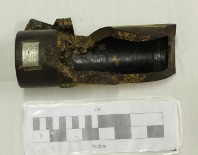
The submarine was firing three inch shells and the Inspector produced a piece of one which was found near to where Mrs Slaughter was injured. It bore the name "Krupp" and was evidently German.
The jury returned a verdict that death resulted from the explosion of a shell fired by a German submarine.
Another Seaham inhabitant however, Carl Mortinson, a miner of 14 Doctor Street, had a very lucky escape. The nose of a shell demolished part of the back yard wall, flew across the room and dropped near the front door without harming any of the occupants. Only Mrs Mortinson was in the kitchen and the shell missed her. The rest of the family were in bed upstairs.
Click on the link below to read the original news aricle as it appeared in the SEAHAM WEEKLY NEWS on July 14th 1916

This edition is a first hand account of the events described above as well as describing how the storm affected shipping at South Shields and as far away as Berwick
___________________________

In Loving Memory Of
Caroline Edith Winter
Who was Murdered at Seaham Harbour
August 2nd 1889
Aged 7 years and 7 months
A Light Is From Our Household Gone
A Voice We Love Is Settled
A Place Is Vacant At Our Hearth
Which Never Can Be Filled
Also James Winter
Beloved Husband Of Jane Ann Winter
And Father Of The Above
Who Died 28th March 1890 Aged 55.years.
After A Long Illness He Departed In Pease
Also Jane Ann Beloved Wife Of The Above
Who Died June 11th 1924 Aged 83.years.
Also Catherine Ann Beloved Wife Of
James Winter
Who Died February 6th 1892, Aged 27.years.
On Saturday morning last a very painful sensation was caused in this town and throughout the neighbourhood on its becoming known that a most brutal crime had been committed on the North Sands close to the town during the previous night, the victim being a little girl, between seven and eight years of age, who had been outraged and cruelly murdered. The circumstances lead to the belief that the child Caroline Edith Winter, daughter of James Winter, screenman, employed at Seaham Colliery, and living in Little John Street, Seaham Harbour, was decoyed from near her father’s house and led away to the sea beach by a man between nine and ten o’clock on Friday night; she was not seen again live. When it grew dark the parents became very anxious as the child had not gone home, they proceeded to look for her, and by some means learned that about nine o’clock she had been with another young girl named Ann Cowell, who is eleven years of age. On applying to Cowell for information they were told that she and Caroline Winter were met in Back North Terrace by a man who was a stranger (at least to Cowell), that he to Winter and said he was her cousin, that he asked Winter to go with him, and said he would give her a shilling. Cowell states that she was going an errand for her mother, and that she spoke up and asked Winter to go with her, and that she replied “No I am going with my cousin.” The stranger than took the child by the hand and led her off along the Back Terrace in the direction of the sea beach, while Cowell, after watching them for a short distance along the Terrace, went to complete her errand. On receiving this information James Winter went at once to the Police Station and gave information as to his child being lost, and the particulars he had heard about the man taking her away. Inspector Burrell lost no time in drawing together all his available force and a thorough search was made along the sea banks and also along the beach. From half-past eleven on Friday night till near six o’clock on Saturday morning the sea banks from Seaham to Ryhope were searched by the officers, and also by several anxious relatives and friends of the missing child. Northing, however, was discovered as to the fate of the girl until about seven o’clock on Saturday morning. About that time a young man named Harry Smith, son of Mr Smith of the Blandford Hotel, Seaham Harbour, was walking along the beach accompanied by a greyhound dog, which he had taken out for exercise, At a little distance from the Featherbed Rock, on the south side of it, the Dawdon Burn, after flowing for a considerable distance through a deep ravine from Dawdon Dene, empties itself into the sea. At this spot is a wide open space amphitheatrically in form, and at the upper end is the mouth of a stone culvert by which the burn is carried under the North Road. Beyond this open space and only a few yards further north is a sort of cave under the projecting cliffs. When opposite this cave Smith’s dog stopped and seemed uneasy, unwilling to stay behind his master and unwilling to leave the cave. This naturally drew the young man’s attention to the spot, and on going closer up to the cave he saw a little girl’s hat in the middle of a pool of blood. Shocking at the discovery, and suspecting that there was something wrong, he went a few yards further on thinking he might meet someone to whom he could communicate what he had seen, when on reaching the open space before referred to he saw two men in the act of lifting the body of a little girl out of a pool of water, the pool being near the mouth of the culvert. Smith saw that the forehead of the child was shockingly bruised, and had evidently bled much. He told the men that had seen the hat and blood in the cave, and then proceeded on to the Police Station, where he gave information of the circumstances to Inspector Burrell and Sergeant Donnegan, who at once supposed that the body would be that of the poor child for whom during the night all had been seeking, and the supposition was correct. The body was brought up from the beach and conveyed to the dead house at the Infirmary, and was identified by James Winter as that of his daughter Caroline Edith Winter. From that time to the present the efforts of the police, both here and throughout the whole of the district, have been unceasingly, directing to the finding out of the murderer. Unfortunately, they may be said to be without a clue, as the only meagre scrap of information they have had is the statement of the little girl Cowell. Rumours at first circulated respecting the man taking the child Winter into Mr Donaldson’s shop to buy sweets led to the hope that some reliable description of the fellow would there be obtained, but it was found on inquiry by the police that he had not been there. A very evident feature of the case is that the murderer is some one well acquainted with the locality. A stranger would not have been likely to find his way when darkness was settling in to a spot so suited for the commission of a crime, that part of the being on the land side in a manner shut in by projecting rocks. He had apparently led the girl straight to the cave, there first outraged her, and then beaten her to death with some of the pieces of rock and sharp stones which strew the beach. The body had than been carried round the corner formed by the projecting rocks, and thrown into the pool near the culvert where it was found. Although most unlikely that any one would be on the sands near the spot at that hour many people would be passing along the road above, but no one has reported having heard any cry.
During the night the police and some of the child’s friends who were assisting in the search for her passed and repassed the place but neither heard nor saw anything to indicate that they were close to the where so awful a crime had been committed. When first seen in the morning by the man who went to cut grass the girl was lying on her back in the pool, with her feet and hands out of the water. The face and head were very much bruised. There were three jagged wounds on the face, one above each temple, and one in the middle of the face. These cuts could hardly have been caused by a fall, and to confirm the belief that the girl had been shockingly murdered, two pieces of rock were found covered with clots of blood and splinters of bone. Those who were early on the spot describe the condition of the girl as most shocking. Her hands were also bruised, and her fingers lacerated. When discovered the body was at once conveyed to the Infirmary. Dr Dillon early saw the body, and described the wounds which have been already mentioned. He also expressed the opinion that the child had been outraged, but withheld any further comment until the inquest.
As soon as the affair became known crowds of people gathered at the place where the body had been found. Anger and pity were the predominating feelings, and had the murderer been found during the morning when the crowd was largest, it would have gone hard with him. In confirmation of the statement that the man had given the child money to buy sweets, a packet of sweets, half emptied, was found in the cave during the day.
Much sympathy is felt for the parents of the deceased girl, they have only lived in the town about six weeks, having removed here from Seaham Colliery, the father being in poor health.
An inquest was opened on the body on Monday afternoon, at the Infirmary, before Mr C. E. Barnes, deputy-corner. Superintendent Wilkinson and Inspector Burrell were present on behalf of the police. Mr John Richardson was appointed foreman of the jury, who then proceeded to view the body.–The only witness called was James Winter, of 2 Little John Street, who said he was a screenman
screenman when he was working. He identified the body viewed by the jury as that of his daughter, Caroline Edith Winter. She was seven years and seven months old.–Mr Barnes said the police did not wish that any further evidence should be taken then. They merely wished the body to be identified and then to have an adjournment for a fortnight to see what evidence could be got in the meantime.–The inquest was adjourned until Monday, the 19th inst., when it will be continued at half-past ten in the morning at Seaham Police Court.
On Tuesday [August 6th] the funeral of the victim was held, the burial taking place at Christ Church, New Seaham, at which village the parents recently resided, and because other relatives of the family are interred in the same graveyard. Two o’clock was appointed as the hour for the departure of the funeral procession from the home of deceased. Many beautiful wreaths which had been sent by ladies and gentlemen of Seaham Harbour were laid on the coffin, and a very touching feature of the funeral procession was the presence of a number of children from the Infant School at New Seaham, former schoolfellows of the deceased, each one carrying a little posy of simple flowers. When the hearse containing the coffin moved away, there was a tremendous crowd of spectators. All along the line of the route was an unbroken throng of people standing on each side. Arriving at the churchyard gate, the Revd Canon Scott, vicar, met the mourners, and commenced the reading of the burial service. The reverend gentleman gave a short but solemn address to those present, the church was crowded, and many had to remain outside. After the father, sister, and brother of the child had taken a last look, the friends and others standing round threw flowers on to the coffin, and the scholars passed round the feet and deposited their bouquets also, until the grave was filled to the depth of nearly twelve inches.
The following description of the man wanted has been sent to all the police stations in the north, and is as follows:–“A man, unknown, supposed age about 30; height, 5ft 5in; complexion, dark, black moustache, dressed in dark, ragged jacket, vest, and trousers, and black hard felt hat.”
Several men have been taken into custody on suspicion by the police in various parts of the county, but were afterwards liberated. Since the first finding of the body of the child, Inspector Burrell has not allowed the least scrap of information to be discarded without sifting it to the bottom. Superintendent Wilkinson has been none the less active then his subordinate. The sergeants and constables in the subdivision of Seaham Harbour have likewise done their very best, and have exercised great energy and alacrity in following out the instructions of their superiors. The idea of the crime having been committed by a tramp has never been held by persons who have carefully thought the matter over. The police at the present time are not without hope that they have some clue to the miscreant, and their efforts will be best assisted by reticence on the part of the press until something more decisive is known
The excitement caused in Seaham Harbour ten days before by the murder of the child Caroline Edith Winter, had somewhat subsided, when on Monday morning last [August, 12th ] a renewal to some extent of the sensation was caused by finding of a man’s jacket, apparently of blue serge, with side pockets, of the kind usually worn by sea going firemen, and a portion of a woollen shirt and a cap, on the beach by a boy named John Bolton and a man named William Greenwood. These articles were found under a ledge not far from the cave where the girl is believed to have been murdered on the night of Friday, the 2nd inst. The clothes were taken possession of by Inspector Burrell, who received immediate information of the discovery. The assumption was at once come to by the popular mind that the articles belonged to the murderer, and it was further concluded that he had committed suicide. On examination, it could not be said positively whether some marks observed on the clothes were blood stains, and a more critical inspection was reserved for an expert. The agitation thus aroused was, however, intensified to a much higher degree when, at about six o’ clock on Monday evening, [August, 12th] the dead body of a man was found almost in the immediate vicinity of where the clothes referred to were picked up. The body was first seen lying at the edge of the water by three women, strangers to the town, one of whom was Miss Mary Jane Johnson, of Little Eppleton, near Hetton-le-Hole. These people had come to Seaham for the afternoon on purpose – it is stated – to see the cave where the child Winter was recently murdered, and the place where her body was found. They had just got sight of the body of a man lying on the sands, when Mr H. W. Richardson and Miss Richardson of North Terrace, Seaham Harbour, who were walking on the sands, came in sight, and the women, who seemed much alarmed, beckoned and called to them to hasten on. On reaching the place they saw the body of a man lying close to the water’s edge. After sending a messenger to the police station with the information, Mr Richardson, with the assistance of a man who had been standing on the banks and seeing that there was something going on below, went down to the beach, got the body pulled up a little further from the water on to the dry sand. Sergeant Donnegan was at the Police Station when the message was delivered, he at once summoned P.C.’s Featherstone, Reed, and Veale to his aid. Calling at the Infirmary as they passed and getting the ambulance stretcher, they all proceeded to the beach and subsequently conveyed the body to the dead house. The only clothing on the body was a pair of dark tweed checked trousers, pair of braces, one sock, and a boot on the right foot. The deceased had the appearance of being fairly well nourished. The age of the man might be about 45 or 50. The hair on the head, turning grey, had originally been of a lightish brown colour, the crown and partly down the back of the head was bald, light moustache, also turning grey, no whiskers, complexion fair, about five feet five inches in height, medium build, rather a military appearance, the hands quite smooth, not like those o’ a workman. The deceased appeared to have been shaved a very short time before death. The body had not been many hours in the water. The forehead and face were cut in places, and one eye quite swollen up. A large and excited crowd soon gathered around the Infirmary, among whom the opinion was freely expressed that the deceased was none other than murderer of the little girl Caroline Winter.
Inquest
On Wednesday [August, 14th] morning, Mr C. E. Barnes, deputy coroner, held an inquest at the Infirmary on the body of the man (unknown) who was found lying on the North Sands on Monday [August 12th] evening. Police Superintendent Webster, from Castle Eden, Police Inspector Burrell, were present at the inquiry.
Harrop Wight Richardson, journalist, was first called. He deposed to being on the beach on Monday night last, about six o’clock, when his attention was called by a young to the dead body of a man lying within the wash of the sea. Witness at once sent information to the police office, and then, with the assistance of a man who came up, dragged the body on to a higher part of the sands. Before the arrival of a policeman, witness examined deceased, and found several bruises on the forehead and face, which were bleeding. The body was quite flaccid. One foot was bare, and the other foot had on it a stocking and a boot. The body had also on it a pair of trousers and a waistcoat, but no shirt. The braces were properly fastened over the shoulders. Witness did not know the man.
Matthew Shotton, living at No. 6, Warren Street, Sunderland, a rivetter, said he and another man were walking into Seaham Harbour from Sunderland on Monday morning last, about a quarter to six o’clock. When nearing the volunteer battery, they saw a man like deceased coming along the road from the opposite direction. The man was walking very quickly, and suddenly he turned down the bank leading to the beach. The man had on a cap similar to the one shown to witness at the dead house. Witness could not say positively that the dead body he had seen was the same person he saw go on the beach. Witness did not known what became of the man after he went down the bank. When witness heard of a man having been found drowned, he give information of what he had seen to Inspector Burrell.
Dr. Dillon deposed to making a post-mortem examination of the body of deceased on Tuesday afternoon. Witness found the body well nourished. Death appeared to have taken place about two days before. The hair of deceased was of a dark chestnut colour, tinged with grey, and very fine in texture. Deceased had no beard or whiskers. He had a steel grey moustache. Witness otherwise described the body. Two teeth were wanting. The face was much bruised and stained with blood. There was a small ante mortem wound on the bridge of the nose. The left eye was closed from effusion into the upper eye lid, the result of a seyero bruise during life. There was a mark almost an inch square on the inner side of the right thigh from varicose veins, about three inches above the knee. The internal organs on the whole were healthy. Witness was of opinion that death resulted from drowning, and that the body was stunned before immersion. The wounds seen on the forehead and face might have been caused by a blow from a blunt instrument, or by a fall on a flat rock, providing deceased had fallen from a great height. A stand up fall would not have produced the bruises. It would take considerable force to cause the injuries. There were bruises on the shins, which might have been caused by washing against the rocks. The body appeared to have been in the water about twelve or fourteen hours. This would make the intervening period coincide with the time the witness Shotton saw the man he referred to. Deceased was about forty five years of age, and slightly bald above each temple. The hair was thin. If deceased had fallen from the high rocks near where found, this would account for the bruises.
Sergt. Donnegan then gave evidence, and said on examining the body of deceased, he found nothing to indicate who deceased was. There was nothing about the body, except a small comb. The trousers had on them patent buttons, marked “Newgate Clothing Company,” which witness had ascertained was a Glasgow clothing firm. Witness showed the coroner and the jury a coat and cap which were found near to where found near to where deceased was found, about twelve hours previously. In the trousers which the man had on was a rule pocket, which had not been put in by a tailor. Witness was of opinion that the water could not possibly have washed the shirt off. He also believed that deceased’s coat was off before he came in contact with the water.
The Coroner thought it peculiar for the shirt to be off and the vest on.
Some of the jurymen thought deceased might not have had a shirt on.
This being all the evidence, the Coroner addressed the jury, and remarked that unless they were not satisfied with the evidence produced, and wished to adjourn the inquest, they could only return a verdict of “Found drowned.” The evidence of the doctor showed that the bruises spoken of had been done before death, but fair reason had been given for their appearance. Unless Mr Burrell wished the inquiry to be held over, he thought the verdict mentioned might be returned.
Inspector Burrell stated that he made inquiries sufficient to cause him to believe that no more evidence regarding the death of deceased could be obtained. It could not with certainty he said the jacket and cap picked up at a previous part of the day belonged to deceased. He had, since the body was found, picked up the other boot. It was not laced, and might have been washed off with the water.
The jury, agreeing with the remarks of the Coroner, returned a verdict of “Found drowned.”
The features of deceased have been photographed for the use of the police.
The remains of the deceased man were interred at the cemetery on Wednesday afternoon. The body had not been identified. Previous to the interment photographs of the features were taken by Mr Lawson, photographic artist, Seaham Harbour. No inquiries have been made of the police authorities here, or information given respecting any person missing, although a description of the deceased has been widely published by the daily press. It is thought in some quarters that the body found is that of the murderer of the little girl Winter; should there be any evidence substantiating that opinion it will no doubt be brought forward at the adjourned inquiry into the death of Caroline Edith Winter, which is fixed for Monday next.
The Murder Of A Child On The Beach
The adjourned inquest on the body of the little girl Caroline Edith Winter, who was murdered on the North Sands on the night of Friday, August 2nd, was resumed at the Seaham Police Court on Monday morning, before the Deputy-Coroner, Mr C. E. Barnes.–The case for the police was watched by Superintendent Wilkinson and Inspector Burrell.
Dr Dillon first gave evidence. He described the fearful injuries the deceased had received to the head and body, and said that death had resulted from a fracture of the skull. The Lower part of the body was lacerated and torn, and the child had been outraged. Stones produced by Supt. Wilkinson would have caused the injuries to the head of deceased. The stones–three large and jagged ones–were marked with blood.
Mrs Donaldson, who keeps a confectioner’s shop on Back North Terrace, said she last saw the deceased on the night of Friday, August 2nd, a little before 9 o’clock, when she went into the shop to buy two eggs. Witness did not see the deceased alive.
Ann Cowell, 10 years of age, living with her parents at Little John Street, said she knew Caroline Edith Winter, and last saw her alive on the night of August 2nd at nine o’clock, or a little after. Deceased had a halfpenny, and went to Mrs Donaldson’s shop to buy some cocoanut nibs. Whilst standing beside Mrs Donaldson’s shop a man came up and took hold of the arm of deceased. She would know the man again if she saw him. The man did not speak to them, but he took Caroline into the shop and bought her a halfpenny worth of bullets. After they came out the man and Caroline went along the Back Terrace, towards Sebastopol Terrace. Witness stopped beside Dr Beatty’s house, and watched the Man and deceased go along the North Road, to where the gate stands which leads to the sands. Witness then went to the chemist’s shop, where she had had at first been sent, and then returned home. She never saw the man again, nor did she again see Caroline alive. The man had his hat over his eyes. Witness could only see his moustache. Caroline seemed to know the man, because she went away so quietly with him. He did not show the shilling. He told Caroline that he was her cousin. Witness asked deceased if the man was her cousin. Caroline laughed, and said “Yes.” Witness said, “Come along with me Caroline, and I will give you a halfpenny.” Deceased replied, “No, he is going to give me a shilling, and I will go with him.”
By the Foreman: The man’s dress was all in rags.
The Coroner: He talked like a pitman.
By a Juryman: Witness did not go into the shop with the man and deceased.
By the Coroner: She saw the body of the man who was drowned, but it was not like that of man she saw with her companion.
John Hamilton, of Back North Railway Street, pitman, said that at about eight o’clock on Saturday morning, August 3rd, when out with his brother and a dog on the sands, he noticed something, which he thought the figure-head of a ship, in a pool of water near the culvert of Dawdon Burn. He went to make an inspection, and found it was the body of a child. He pulled it out. His brother went for the police, and he remained by the body until Sergeant Donnegan arrived. He noticed there were cuts about the head, and the clothes on the body were lifted up and rolled round the her waist. All the body was under water
David Hamilton, miner, of 3,Frances Street, corroborated the statement of his bother, the previous witness.
Mrs Donaldson (re-called) said she did not see the little girl Winter come in on the night of the 2nd of August to get any sweets with a man. No man came into the shop for sweets that night.
Henry Smith, barman at the Blandford Hotel, said that on the morning of the 3rd of August when exercising a greyhound on the sea beach between eight and Nine o’clock he noticed the animal behave in a strange manner, remaining behind in front of the cave. Going back to where the dog was he found a girl’s hat in a pool of blood in the cave. On turning again to proceed towards the town he had only gone a few yards when he saw two men (the Hamilton’s) pulling the body of a little girl out of a pool of water, near to the Dawdon Burn. The distance from the cave to where the body was found was 85 yards.
Sergeant Donnegan said that on the 3rd inst., at about five minutes to nine 0’clock in the morning, he went to the mouth of Dawdon Dene culvert, and there saw the body of the deceased, which had been taken from the water. He also had a white straw hat handed to him. There was blood on it. He noticed the injuries described by previous witnesses, and also that the dead child’s hands were clenched, bruised and cut, as though they had been struck by something. By his direction the body was taken on a stretcher to the Infirmary, where a post-mortem examination was made by Dr Dillon. Witness examined a cave pointed out by him by Smith, and there found a pool of blood, about four yards from the entrance. The cave extended back seven and a half yards from the entrance, and was four feet high over the spot where the blood was found. He was able to trace the blood from the cave to the pool, and about five yards from the mouth of the cave there was a clot of blood, as though the body had been put down there to enable the person carrying it to get a better hold. He took a number of stones from the cave which were bloody. They also had skin and hair sticking to them, and were the same as produced that morning.
This was the whole of the evidence.
The Coroner, addressing the jury, said there could be no doubt that a brutal murder had been committed, and it was a great pity that no one had been taken into custody who could be identified with it. He did not think any benefit would be obtained by adjourning the inquiry again, but if the jury desired it he would do so.
The Foremen intimated that the jury did not think a further adjournment necessary.
The Coroner continuing said he did not think the evidence, which was so simple, required any explanation or comment on his part. The jury had no alternative but to find that a murder had been committed, and thought they would agree that it had been committed on the night of the 2nd of August.
The jury returned a verdict of wilful murder against some person unknown.
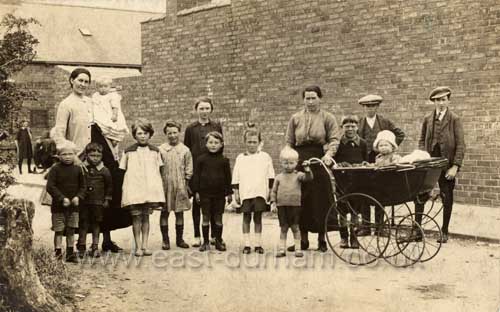
Seaham - Colliery Street

Seaham Lifeboats · Skynner crew circa 1895